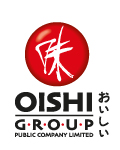OISHI’s Value Chain
Developing the value chain is a key strategy for business success. Therefore, OISHI pays attention to every step and every process of the value chain to strengthen trust in quality products and sustainable growth together.
1. Sourcing
• Develop the potential of business partners to achieve goals and grow sustainably with OISHI, by establishing
guidelines for partners, risk management for products and services. The work has been checked to meet the standards and proper management process, and promote sustainable quality improvement by defining systematic assessment criteria.
• OISHI works closely with partners in planning the procurement of raw materials, including the provision of substitute raw materials in case of emergency for business continuity. Regular meetings with key suppliers are held for the procurement of raw materials.
• Collaborate with companies in ThaiBev Group in order to get the most benefit from the synergies in the procurement of raw materials, which allows for better bargaining power, and to ensure that the raw materials meet the specified criteria.
• Provide a standard procurement process that takes into account environmental and social factors, such as energy management, occupational health and safety, including corporate governance to ensure that products and services are delivered to consumers safely and with quality.
• Pay attention to the safety of consumers with regard to the post-consumption effects.
2. Production
• Create innovative products that respond to the trend of consumers who care about health and good hygiene.
• The quality of products is controlled according to legal requirements and various international management standards, covering the environment, safety and consumers, such as ISO 9001, ISO 14001, ISO 22000, GMP, HACCP and BRC standards.
• Select raw materials that are of good quality and safe for consumers.
• Good safety and hygiene are managed within the factory and production sites.
• Use various resources in the most cost-effective manner without causing pollution to the environment and society, both in terms of water resources and various energy. Renewable energy is used and the Solar Rooftop system is installed to generate electricity. There is also continuous development of innovation and technology in various fields.
3. Distribution
• Paying attention to maintaining product quality, and delivering good quality products to customers, coupled with professional services.
• Using modern technology in the management of logistics and distribution systems, such as establishing a safe driving discipline system for drivers and fuel energy management for maximum efficiency.
• Using a temperature-controlled distribution system for food products, to maintain quality from the factory to the consumer.
• Expanding restaurant branches in various formats to suit the situation to meet the New Normal lifestyle and changing consumer behavior, such as OISHI FOOD TRUCK, mobile food trucks that combine various brands of OISHI Group, focusing on the strategies of convenience, speed, ease of access, and can be moved according to changing situations, or OISHI TO GO, which is a To Go service that sells ready-to-eat Japanese-style meals to meet the lifestyle of the new generation who has a hurried behavior with little time, and demands for convenience and speed, but also looking for products that are healthy and easy to carry, such as Donburi, Salad, Sushi, and Onigiri. They also sell ingredients for easy Japanese cooking at home.
• The restaurant business expands the integrated sales channel by using the restaurant as the center. Consumers can shop through online channels by specifying branch/pick up point as well as the date and time of receiving the products as needed.
• OISHI participated in the “PackBack: Taking Back the Packaging for Sustainable Days” project of Minister of Natural Resources and Environment, Pollution Control Department, and Thailand Institute of Packaging and Recycling Management for Sustainable Environment (TIPMSE), which using the concept of Extended Producer Responsibility or EPR in driving the circular economy according to the BCG (Bio Economy, Circular Economy, Green Economy) economic model. The EPR concept guides packaging management throughout the product life cycle with the principle of extending the responsibility of producers to different stages of the packaging life cycle, to achieve packaging recycling after consumption. This will reduce negative impacts on the environment and ensure sustainable development. If manufacturers can accept returns of goods or products back from consumers or buyers, it will be another key to enable Thailand to realize the Circular Economy under the coordination and integration of joint operations from all sectors and drive Net Zero Emission goal that the government has set.
4. Marketing and Sales
• Strategic plans have been adjusted in accordance with the current situation and to accommodate the changing consumer behavior from the COVID-19 crisis in order to maintain market leadership and create growth.
• Expand service coverage, for example, increasing the variety of food menus by using the kitchen in the current shop under the service name “OISHI Kitchen”, resulting in increasing sales opportunities for brands that do not have stores located in that area.
• Incorporating digital technology to enhance customer convenience and safety.
• Focus on adding new channels in sales and reaching customers, including:
- Food Aggregator: Expand sales channels through Food Aggregator partners to generate online sales and increase food delivery service efficiency.
- e-Market Place: Increase sales opportunities with O2O marketing by visiting trading groups with targeted customers via e-Voucher format.
- WWW.SHOPTEENEE.COM: Expand distribution channels for food and beverages of the OISHI Group through e-Market Place Platform in the form of website and mobile application.
- BevFood: Application that facilitates customers in a comprehensive way which can be used to carry out various activities in a single application, such as ordering food online with delivery service or choose to pick up at the branch, table reservation, as well as collecting member points, and converting points to cash coupons.
• Build good relationship with customers through various marketing campaigns including the creation of OISHI CLUB application of the beverage business that helps increase convenience for consumers to participate in various activities, especially exclusive activities with special privileges to win and redeem rewards. It also creates a brand loyalty and good relationship with customers who love OISHI Green Tea. While the food business has a BevFood application that provides complete convenience to customers, both ordering food and collecting points from using the service; reward points to be exchanged for discount coupons instead of cash; and pressing eCoupon to receive benefits from the promotional activities organized by brands.
• Communicate and publicize the responsibility to consumers and society, and organize promotional activities to build relationships with consumers, together with hearing opinions from consumers through communication channels to develop and meet the needs of customers as much as possible.
5. After-Sales Service
• There is a team to coordinate with customers in case of an incident that causes customers to have doubts, or dissatisfaction with products and services.
• On the label of OISHI Green Tea products contain call center number for any complaints/suggestions and further information of the products. The company’s website and social media channel also specified on the label as well.
• OISHI has created a QR Survey at the end of restaurant receipts to collect information about customers who leave comments, suggestions and feedback. If there is any problem that the customer scores lower than the specified standard, there will be an email informing the service shop immediately to fix the problem and notify the operation to be completed within the period specified in each topic. Every opinion is therefore an important source of information that will be analyzed, screened, in order to develop, improve and help the organization to respond to customer needs faster and more efficiently.


